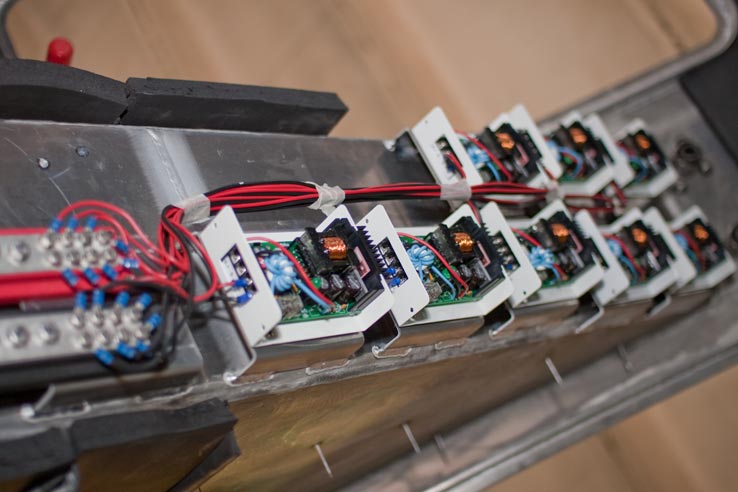In governments and in sailing yachts….
Since the Journeyman aims to be an environmentally friendly yacht in all respects, I have decided not to fit any generator. At all. Not even a shore power charger! Well… that’s maybe also because shore power is a dangerous thing to have in an aluminum yacht to start with.
Anyway, we will rely 100% on solar power. To be able to fit as much solar power on the deck-house roof as possible I am using so called back-contact solar cells, which have a higher efficiency than traditional marine solar panels. These panels do have the issue that you can’t connect them all to the same charge regulator, due to electrostatic charge buildups that destroy performance.
So instead I am fitting each solar panel, 8 in total, with its own maximum power point tracking regulator. This means that each individual panel will be used to the maximum extent possible at all times, which is a good thing when some panels are partly shaded or at bad angles to the sun. As you can guess this happens pretty much all the time.

Comments
8 responses to “Power needs to be regulated”
Hej Jesper,
Kommer du ha någon vindgenerator?
Mina erfarnheter efter ha seglat Explorer of Sweden i närmare ett år är att vindgeneratorn ger mycket mer ström än solpaneler…
/Oscar
En vindgenerator ger mer än en solpanel. Men inte än 8 solpaneler :-)
De installerade solpanelerna motsvarar ungefär tre-fyra vindgeneratorer i effekt beroende på generatormodell.
Jag gillar solceller, dom går inte sönder och väsnas inte. Men ska man bara ha max ström för lite pengar är en vindgenerator bättre. Mest ström får man såklart med båda eftersom dom kompletterar varandra i olika väderlek. Men den första Journeyman 60 utrustas med tillräckligt med solceller för att inte behöva någon snurra.
Va?? ska du inte ha någon Garo nu?
Joo… men den går inte till nån laddare, bara till ett par uttag :-)
Jesper, do consult with qualified eletrician about shore power and aluyacht – with electricity properly done it is not possible to die by dropping hair fan into a bathtub…
Don’t worry, AC installation is done according to CE standards. Plus I have a Master of Science degree in Electrical Engineering… (Which actually does not say much about doing things in safe ways, but anyway… :-)
I’m not worrying if the eletricity in current configuration is properly done – on the contrary :) I was rather wondering about the decision of not using shore power – what are those risks you are trying to avoid?
Connecting an alloy yacht to shore power will make it part of the shore electric system, AND all other yachts around it. Ground currents will flow uncontrolled and most of the time eat away your anodes rapidly through electrically induced corrosion. When the anodes are gone the hull is next in turn…. Those of us who live in the Baltic don’t see this problem so often, because of the cold water and low ionization (salt level). But I can assure you there are plenty of scary examples from warmer and salter parts of the world.
Ground currents can be avoided to some extent by using a galvanic isolation transformer, which is a really really heavy piece of equipment for 240V/16A. And even with that there is still a risk that any piece of equipment that is connected to AC power will have small grounding leakages, which again will result in corrosion.
You can read more for example in some of these links:
http://www.yachtsurvey.com/corrosion_in_marinas.htm
http://yachtpals.com/how-to/electrolysis
http://www.centralyacht.com/library/corrosion.pdf (Very good technical paper!)